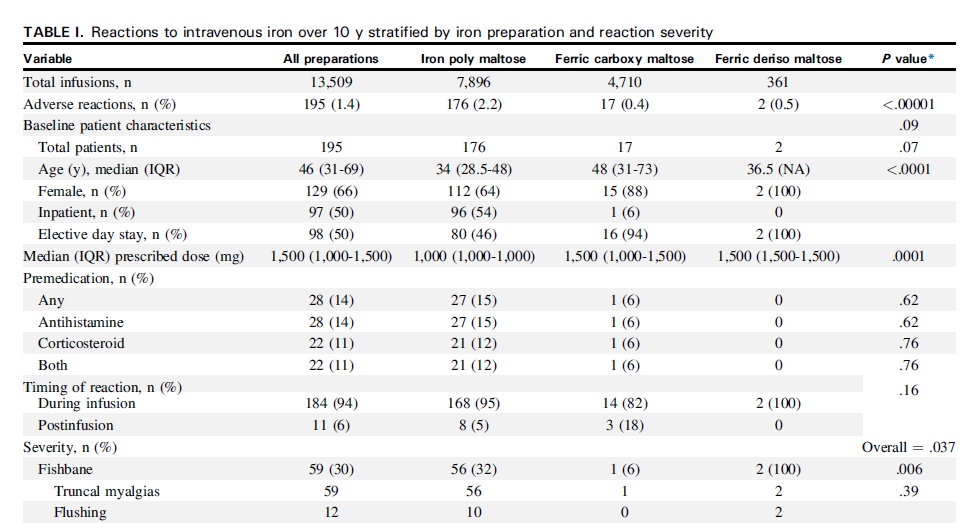1/
A Patient Receiving H...

Highlights
1/
A patient receiving his first-ever dose of IV Iron (ferumoxytol) suddenly develops diffuse face & trunk flushing, chest pain, myalgias, and anxiety.
Blood pressure is normal and lungs are clear.
You are called to the bedside to assess.
How likely is anaphylaxis? (View Tweet)
2/
To decide on the answer, let’s review the diagnostic criteria for anaphylaxis.
The 2006 NIAID/FAAN guidelines say anaphylaxis is likely if one of the three criteria below are fulfilled:
A key feature is rapid onset (within minutes to hours).
https://t.co/O8kPIkirYP
 (View Tweet)
3/
(View Tweet)
3/
Other clues:
🔑Skin involvement present in up to 90% of cases.
🔑Hypotension and respiratory involvement are common.
The 2020 World Allergy Organization criteria are simpler and say anaphylaxis is likely if one of two criteria below are met:
https://t.co/Ea8duS4OCY
 (View Tweet)
4/
(View Tweet)
4/
Now what do you think - is this patient experiencing anaphylaxis? (View Tweet)
5/
Anaphylaxis is unlikely.
Instead, this patient is having a non-immunologic infusion reaction known as the FISHBANE reaction.
It was first described in this series of hemodialysis patients receiving iron dextran:
4.7% had reactions; few were severe.
https://t.co/I9ZiFFzvVl

 (View Tweet)
6/
(View Tweet)
6/
What is the Fishbane reaction?
It is an acute, self-limited & non-life-threatening reaction to IV Iron.
It includes transient flushing or erythema, chest or back pain/tightness, and myalgias/arthralgias.
https://t.co/JMWyjLY8WP (View Tweet)
7/
The mechanism is poorly understood.
It is thought to be specific to IV iron, but NOT IgE-mediated.
The leading hypotheses are:
🔑Complement activation-related pseudoallergy (CARPA)
🔑An effect of labile free iron atoms
https://t.co/rEiaHgZwPR (View Tweet)
8/
Knowing the pre-test probability of each of these conditions can help us refine our diagnostic approach.
To estimate these probabilities, let’s use incidence rates from population-based studies.
First, how common is anaphylaxis from IV iron, per 10,000 first-time infusions? (View Tweet)
9/
For many common IV iron preparations, the risk of anaphylaxis is on the order of 1 – 10 episodes per 10,000 first infusions.
Iron dextran seems to have the highest risk.
(IR = incidence rate)
https://t.co/dHWC9T1A7O
 (View Tweet)
10/
(View Tweet)
10/
Next, how common is the Fishbane reaction from IV Iron, per 100 first-time infusions?
Note the clue that the denominator for these choices is 100x smaller than for anaphylaxis! (View Tweet)
11/
In this study of 13,000 infusions, reactions occurred in 1.4%; 30% were Fishbane.
Another study of 35,000 infusions found reactions occurred in 3.9% of infusions (only 2 of which required epinephrine).
Close to ~1/100
https://t.co/3WtkVgInEM
https://t.co/twqoFPiF56

 (View Tweet)
12/
(View Tweet)
12/
Given this, we can infer that most reactions to IV you will be called about are NOT going to be anaphylaxis.
The Fishbane reaction is thought to occur 100x more frequently!
The key is applying the diagnostic criteria for anaphylaxis so as not to miss the diagnosis. (View Tweet)
13/
In closing, now that you’ve diagnosed the Fishbane reaction, what should you do? (View Tweet)
14/
Similar to the vancomycin infusion reaction, once anaphylaxis has been ruled out, you should resume the infusion at a slower rate.
https://t.co/JMWyjLY8WP
 (View Tweet)
15/
(View Tweet)
15/
Take-home points:
The Fishbane reaction is a common, non-IgE-mediated reaction to IV iron (~1 in 100)
Anaphylaxis from IV iron is uncommon (~1-10 in 10,000)
hypotension and respiratory involvement differentiate them
Use pretest probability to guide diagnosis
(View Tweet)
Huge thanks to @tony_breu for providing thoughtful peer review.
Feedback for improvement welcome! (View Tweet)


 (View Tweet)
(View Tweet) (View Tweet)
(View Tweet)
 (View Tweet)
(View Tweet) (View Tweet)
(View Tweet)
 (View Tweet)
(View Tweet) (View Tweet)
(View Tweet)